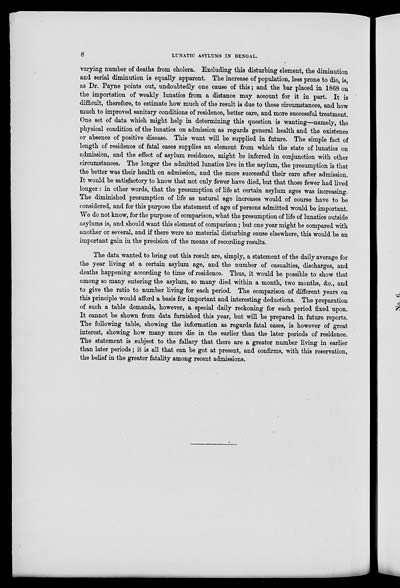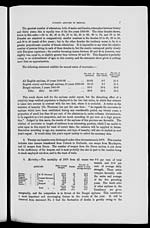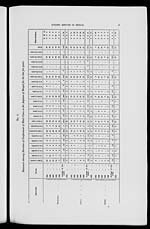Medicine - Mental health > 1867-1924 - Annual report of the insane asylums in Bengal > Insane asylums in Bengal annual reports 1867-1875 > Annual report on the insane asylums in Bengal, for the year 1870
(314) Page 8
Download files
Individual page:
Thumbnail gallery: Grid view | List view

8 LUNATIC ASYLUMS IN BENGAL.
varying number of deaths from cholera. Excluding this disturbing element, the diminution
and serial diminution is equally apparent. The increase of population, less prone to die, is,
as Dr. Payne points out, undoubtedly one cause of this; and the bar placed in 1868 on
the importation of weakly lunatics from a distance may account for it in part. It is
difficult, therefore, to estimate how much of the result is due to these circumstances, and how
much to improved sanitary conditions of residence, better care, and more successful treatment.
One set of data which might help in determining this question is wanting—namely, the
physical condition of the lunatics on admission as regards general health and the existence
or absence of positive disease. This want will be supplied in future. The simple fact of
length of residence of fatal cases supplies an element from which the state of lunatics on
admission, and the effect of asylum residence, might be inferred in conjunction with other
circumstances. The longer the admitted lunatics live in the asylum, the presumption is that
the better was their health on admission, and the more successful their care after admission.
It would be satisfactory to know that not only fewer have died, but that those fewer had lived
longer: in other words, that the presumption of life at certain asylum ages was increasing.
The diminished presumption of life as natural age increases would of course have to be
considered, and for this purpose the statement of age of persons admitted would be important.
We do not know, for the purpose of comparison, what the presumption of life of lunatics outside
asylums is, and should want this element of comparison; but one year might be compared with
another or several, and if there were no material disturbing cause elsewhere, this would be an
important gain in the precision of the means of recording results.
The data wanted to bring out this result are, simply, a statement of the daily average for
the year living at a certain asylum age, and the number of casualties, discharges, and
deaths happening according to time of residence. Thus, it would be possible to show that
among so many entering the asylum, so many died within a month, two months, &c., and
to give the ratio to number living for each period. The comparison of different years on
this principle would afford a basis for important and interesting deductions. The preparation
of such a table demands, however, a special daily reckoning for each period fixed upon.
It cannot be shown from data furnished this year, but will be prepared in future reports.
The following table, showing the information as regards fatal cases, is however of great
interest, showing how many more die in the earlier than the later periods of residence.
The statement is subject to the fallacy that there are a greater number living in earlier
than later periods; it is all that can be got at present, and confirms, with this reservation,
the belief in the greater fatality among recent admissions.
Set display mode to: Large image | Zoom image | Transcription
Images and transcriptions on this page, including medium image downloads, may be used under the Creative Commons Attribution 4.0 International Licence unless otherwise stated. ![]()
| Permanent URL | https://digital.nls.uk/83378948 |
|---|




